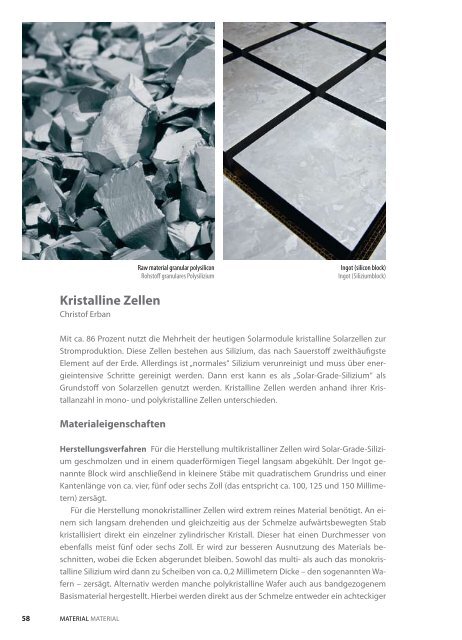Energizing Architecture
978-3-939633-71-6
978-3-939633-71-6
Erfolgreiche ePaper selbst erstellen
Machen Sie aus Ihren PDF Publikationen ein blätterbares Flipbook mit unserer einzigartigen Google optimierten e-Paper Software.
Raw material granular polysilicon<br />
Rohstoff granulares Polysilizium<br />
Ingot (silicon block)<br />
Ingot (Siliziumblock)<br />
Polycrystalline cells with an anti-reflective coating<br />
Polykristalline Zellen mit Antireflexschicht<br />
Kristalline Zellen<br />
Christof Erban<br />
Mit ca. 86 Prozent nutzt die Mehrheit der heutigen Solarmodule kristalline Solarzellen zur<br />
Stromproduktion. Diese Zellen bestehen aus Silizium, das nach Sauerstoff zweithäufigste<br />
Element auf der Erde. Allerdings ist „normales“ Silizium verunreinigt und muss über energieintensive<br />
Schritte gereinigt werden. Dann erst kann es als „Solar-Grade-Silizium“ als<br />
Grundstoff von Solarzellen genutzt werden. Kristalline Zellen werden anhand ihrer Kristallanzahl<br />
in mono- und polykristalline Zellen unterschieden.<br />
Materialeigenschaften<br />
Herstellungsverfahren Für die Herstellung multikristalliner Zellen wird Solar-Grade-Silizium<br />
geschmolzen und in einem quaderförmigen Tiegel langsam abgekühlt. Der Ingot genannte<br />
Block wird anschließend in kleinere Stäbe mit quadratischem Grundriss und einer<br />
Kantenlänge von ca. vier, fünf oder sechs Zoll (das entspricht ca. 100, 125 und 150 Millimetern)<br />
zersägt.<br />
Für die Herstellung monokristalliner Zellen wird extrem reines Material benötigt. An einem<br />
sich langsam drehenden und gleichzeitig aus der Schmelze aufwärtsbewegten Stab<br />
kristallisiert direkt ein einzelner zylindrischer Kristall. Dieser hat einen Durchmesser von<br />
ebenfalls meist fünf oder sechs Zoll. Er wird zur besseren Ausnutzung des Materials beschnitten,<br />
wobei die Ecken abgerundet bleiben. Sowohl das multi- als auch das monokristalline<br />
Silizium wird dann zu Scheiben von ca. 0,2 Millimetern Dicke – den sogenannten Wafern<br />
– zersägt. Alternativ werden manche polykristalline Wafer auch aus bandgezogenem<br />
Basismaterial hergestellt. Hierbei werden direkt aus der Schmelze entweder ein achteckiger<br />
Crystalline Cells<br />
Christof Erban<br />
Most contemporary solar modules—86 percent—are equipped with crystalline solar cells<br />
for electricity production. These cells are made of silicon, the second most common element<br />
on earth after oxygen. “Normal” silicon, however, is impure and must be purified through<br />
various energy-intensive processes. Only after this is done can “solar-grade silicon” be used<br />
as the basic material of solar cells. Depending on the amount of crystals they contain, crystalline<br />
cells are known as either mono- or polycrystalline cells.<br />
Material Properties<br />
Production Process During the production of multicrystalline cells solar-grade silicon is<br />
melted and then slowly cooled in a cuboidal crucible. The blocks, known as ingots, are then<br />
sawn into smaller square-shaped bars of approximately four, five, or six inches in length<br />
(roughly 100, 125, or 150 millimeters).<br />
Extremely pure material is required for the production of monocrystalline cells. A single<br />
cylindrical crystal crystallizes on a bar that turns slowly as it simultaneously leaves the kiln.<br />
Such crystals are usually five or six inches in diameter. They are clipped to ensure optimal use<br />
of material although the corners remain rounded. Both multi- and monocrystalline silicon<br />
is then sawn into approximately two-millimeter-thick slices—so-called wafers. Alternatively,<br />
polycrystalline wafers are also produced by stretching the basis material into strips. In such<br />
a process, either an octagonal hollow cylinder, or a flat, infinite band of silicon is extracted<br />
straight from the kiln. In both cases, crystals develop perpendicular to the direction of tensile<br />
force and parallel to one another. The wafers are then cut, using a laser, into their final<br />
58 Material Material Crystalline Modules Kristalline Module 59


















